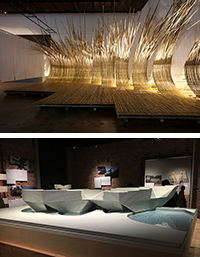 |
 |
 |
 |
Materials, Methods, and Geometries: 30 Years of Creative Exploration by Architect Kengo Kuma |
 |
| James Lambiasi |
 |
Kengo Kuma is perhaps the most renowned Japanese architect currently in practice. His international status has allowed him to attract increasingly notable commissions, carrying his prolific career to ever greater heights. However, the current exhibition of his works, Kengo Kuma: a LAB for materials, is not necessarily a platform he uses to boast over his achievements. On the contrary, Kuma takes this opportunity to highlight the humble source of his architectural philosophy of makeru kenchiku, translated as "losing architecture." "Losing" refers to the notion that it is not the building itself that should be the center of attention, but its ability to respond to its physical and cultural context, and to resonate with nature. more... |
|

|
|
 |
|
